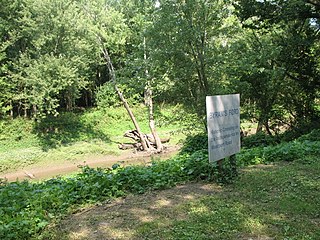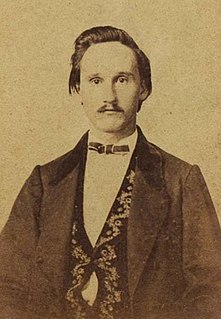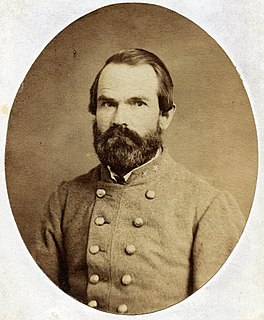Background
Following the Siege of Lexington, Missouri the secessionist Missouri State Guard withdrew to the southwest portion of Missouri. Some Southern recruiters such as Colonel Franklin S. Robertson remained, attempting to fill their regiments. Robertson, a store owner in Saline County, Missouri born in Kentucky had been granted his commission by Major General Sterling Price at Lexington.
Meanwhile, Union Brigadier General John Pope, in command of the District of Central Missouri, was determined to suppress Southern recruiting in the region. He headed Southwest from Sedalia before turning the main body north toward Warrensburg.
Robertson collected his recruits at Grand Pass where they elected officers. On December 16, 1861, the 750 men began their March south. The plan was to first link up with Colonel J.J. Clarkson's recruits near Warrensburg, Missouri before proceeding south to General Price. They were unable to merge with Clarkson but they were joined by Colonel Ebenezer Magoffin, who was on parole after being captured while attempting to recruit his own regiment. Magoffin is notable as the brother of Kentucky Governor Beriah Magoffin.
General Pope learned on the evening of December 18 that Robertson's force would be camped at Milford.
Casualties
Federal casualties were exceedingly light, two killed and eight wounded. General Pope claimed the capture of "1,300 men…three colonels (Robinson, Alexander, and Magoffin)…one lieutenant-colonel (Robinson), one major (Harris), and 51 commissioned company officers" and "About 500 horses and mules, 73 wagons heavily loaded with powder, lead, tents, subsistence stores, and supplies of various kinds…also 1,000 stand of arms." [3] However, this appears to be overstated as records indicate "684 guardsmen and several civilians" eventually reached prison. [4]
Other notables captured
Among the 684 known prisoners marched to Sedalia and carried by rail to St. Louis were several other notables: Ebenezer Magoffin, William Goff Caples, and Bartholomew W. Keown. All three would die before the close of the war.
Of national interest a Missouri military tribunal convicted Ebenezer Magoffin of violating his parole and sentenced him to be executed. Lincoln, sensitive to Kentucky politics (Being a native of that state), intervened on his behalf requesting a review. Before any final disposition could be made, Magoffin and several dozen inmates tunneled out of Alton Prison and escaped. He was killed near the end of the war while intervening in a bar fight in southern Arkansas. [6]
The other two were of more interest to Missourians. William Goff Caples was a fiery secessionist minister and president of the Missouri Conference of the Methodist Episcopal Church South. After six weeks confinement he gave his oath and eventually moderated his politics. He even became supervisor of the telegraph guard for a stretch near Glasgow. In an ironic twist he was killed there by an artillery shell from Jo Shelby's bombardment on October 15, of 1864. [7]
Bartholomew W. Keown (also referred to as Keon or McKeown) was a South Carolinian who had become sheriff of Benton County, Missouri. It was alleged that in this capacity he obtained detailed information about the Benton County Home Guard (Unionist) regiment and relayed it to secessionist militia in Warsaw who launched a successful attack, the Battle of Cole Camp (1861). He died of disease in Alton Prison before he could be tried. [8]
The following is a list of engagements that took place in 1861 during the American Civil War.

The Battle of Carthage, also known as the Engagement near Carthage, took place at the beginning of the American Civil War on July 5, 1861, near Carthage, Missouri. The experienced Colonel Franz Sigel commanded 1,100 Federal soldiers intent on keeping Missouri within the Union. The Missouri State Guard was commanded by Governor Claiborne F. Jackson himself and numbered over 4,000 soldiers led by a hero of Mexico, Sterling Price, along with 2,000 unarmed troops who did not participate in the battle.

The siege of Lexington, also known as the First Battle of Lexington or the Battle of the Hemp Bales, was a minor conflict of the American Civil War. The siege took place from September 13 to 20, 1861 between the Union Army and the pro-Confederate Missouri State Guard in Lexington, county seat of Lafayette County, Missouri. The victory won by the Missouri Guard bolstered the considerable Southern sentiment in the area, and briefly consolidated Missouri State Guard control of the Missouri River Valley in the western part of the state.

The Battle of Lone Jack was a battle of the American Civil War, occurring on August 15–16, 1862 in Jackson County, Missouri. The battle was part of the Confederate guerrilla and recruiting campaign in Missouri in 1862.

The Battle of Byram's Ford was fought on October 22 and 23, 1864, in Missouri during Price's Raid, a campaign of the American Civil War. With the Confederate States of America collapsing, Major General Sterling Price of the Confederate States Army conducted an invasion of the state of Missouri in late 1864. Union forces led Price to abandon goals of capturing the cities of St. Louis and Jefferson City, and he turned west with his army towards Kansas City.

The Battle of Athens was an American Civil War skirmish that took place in northeast Missouri in 1861 near present Revere and southeast Iowa along the Des Moines River across from Croton. The Union victory has the distinction of being the most northerly of Civil War Battles fought west of the Mississippi, and also of being the only such battle fought along the Iowa border.

The 1st Regiment Arkansas Volunteer Infantry (1863–1865) was an infantry regiment that served in the Union Army during the American Civil War. Although Arkansas joined the Confederate States of America in 1861, not all of its citizens supported secession. Arkansas formed some 48 infantry regiments to serve in the Confederate Army, but also formed another 11 regiments that served in the Union Army.
The Battle of Cole Camp was a skirmish of the American Civil War, occurring on June 19, 1861, in Benton County, Missouri. The rebel victory assured an open line of march for the fleeing governor and Missouri State Guard away from Lyon's force in Boonville.

Martin Edwin Green was a Confederate brigadier general in the American Civil War, and a key organizer of the Missouri State Guard in northern Missouri.
The 66th Illinois Veteran Volunteer Infantry Regiment originally known as Birge's Western Sharpshooters and later as the "Western Sharpshooters-14th Missouri Volunteers", was a specialized regiment of infantry sharpshooters that served in the Union Army during the American Civil War. The regiment was intended, raised, and mustered into Federal service as the Western Theater counterpart to Army of the Potomac's 1st and 2nd United States Volunteer Sharpshooters.
Emory S. Foster was a major in the 7th Missouri State Militia Cavalry during the American Civil War. After the Civil War, he was a St. Louis, Missouri newspaper editor. While serving as an editor, Foster fought a duel with rival editor and former Confederate John N. Edwards.
In the American Civil War the Home Guard or Home Guards were local militia raised from Union loyalists.

Shelby's Iron Brigade, also known as the Missouri Iron Brigade, was a Confederate cavalry brigade, led by Brigadier General Joseph O. Shelby, in the Trans-Mississippi Theater of the American Civil War.
Alexander Early Steen was a career American soldier from Missouri who served in the United States Army in the Mexican–American War. He rejoined the army in 1852 and served until he resigned to join the Confederate forces on May 10, 1861. He served as a general in the secessionist Missouri State Guard forces and as a colonel and acting brigadier general in the Confederate States Army during the American Civil War. He was killed in the Battle of Prairie Grove.

The 10th Arkansas Infantry (1861–1865) was a Confederate Army infantry regiment during the American Civil War from the state of Arkansas. The unit is also known as A. R. Witt's Infantry, C. M. Cargile's Infantry, E. L. Vaughan's Infantry, Thomas D. Merrick's Infantry, S. S. Ford's Infantry, Obed Patty's Infantry, George A. Merrick's Infantry, Zebulon Venable's Infantry and Robert C. Bertrand's Infantry in contemporary accounts. After being captured at the Siege of Port Hudson, the unit reorganized as a mounted infantry unit, and was known as the 10th Arkansas Cavalry Regiment or Witt's Arkansas Cavalry.

James McCown was a Confederate States Army officer in the American Civil War.
Ebenezer "Ben" Magoffin (1817-1865) was a Confederate officer in the American Civil War who carried a Missouri State Guard's colonel's commission and became a prominent figure in the early phase of the war in Missouri. He was sentenced to death by a Union Army military commission in 1862, but was spared execution after Kentucky Governor Beriah Magoffin pleaded for the life of his brother with Abraham Lincoln.
Slayback's Missouri Cavalry Regiment was a cavalry regiment of the Confederate States Army during the American Civil War. Originally formed as Slayback's Missouri Cavalry Battalion, the unit consisted of men recruited in Missouri by Lieutenant Colonel Alonzo W. Slayback during Price's Raid in 1864. The battalion's first action was at the Battle of Pilot Knob on September 27; it later participated in actions at Sedalia, Lexington, and the Little Blue River. In October, the unit was used to find an alternate river crossing during the Battle of the Big Blue River. Later that month, Slayback's unit saw action at the battles of Westport, Marmiton River, and Second Newtonia. The battalion was briefly furloughed in Arkansas before rejoining Major General Sterling Price in Texas in December. Probably around February 1865, the battalion reached official regimental strength after more recruits joined.

The capture of Sedalia occurred during the American Civil War when a Confederate force captured the Union garrison of Sedalia, Missouri, on October 15, 1864. Confederate Major General Sterling Price, who was a former Governor of Missouri and had commanded the Missouri State Guard in the early days of the war, had launched an invasion into the state of Missouri on August 29. He hoped to distract the Union from more important areas and cause a popular uprising against Union control of the state. Price had to abandon his goal of capturing St. Louis after a bloody repulse at the Battle of Fort Davidson and moved into the pro-Confederate region of Little Dixie in central Missouri.
Nichols's Missouri Cavalry Regiment served in the Confederate States Army during the late stages of the American Civil War. The cavalry regiment began recruiting in early 1864 under Colonel Sidney D. Jackman, who had previously raised a unit that later became the 16th Missouri Infantry Regiment. The regiment officially formed on June 22 and operated against the Memphis and Little Rock Railroad through August. After joining Major General Sterling Price's command, the unit participated in Price's Raid, an attempt to create a popular uprising against Union control of Missouri and draw Union troops away from more important theaters of the war. During the raid, while under the command of Lieutenant Colonel Charles H. Nichols, the regiment was part of an unsuccessful pursuit of Union troops who were retreating after the Battle of Fort Davidson in late September.













